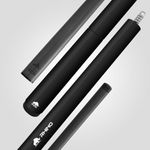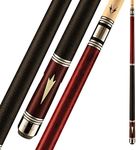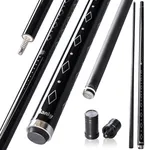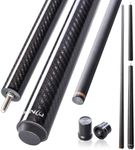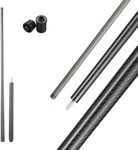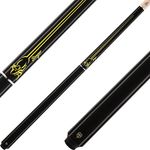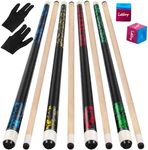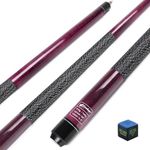Buying Guide for the Best Jump Cues
Choosing the right jump cue can significantly improve your performance in pool or billiards. A jump cue is specifically designed to help you make jump shots, where the cue ball is made to leap over an obstructing ball. To find the best jump cue for you, it's important to understand the key specifications and how they affect your game. Here are the main specs to consider when selecting a jump cue.WeightThe weight of a jump cue is crucial because it affects how easily you can make the cue ball jump. Jump cues are generally lighter than regular cues, typically ranging from 7 to 10 ounces. A lighter cue (around 7-8 ounces) allows for quicker, more controlled jumps, which is ideal for players who need precision. Heavier cues (9-10 ounces) can provide more power but may be harder to control. If you're new to jump shots, starting with a lighter cue might be easier to handle.
LengthJump cues are shorter than standard cues, usually between 40 to 48 inches. The shorter length helps in generating the upward force needed for jump shots. A shorter cue (around 40-42 inches) is easier to maneuver and can be more effective for quick, short jumps. Longer jump cues (45-48 inches) might offer more stability and control for longer jumps. Consider your playing style and the types of jump shots you frequently encounter when choosing the length.
TipThe tip of a jump cue is typically harder than that of a regular cue, often made from phenolic resin or other hard materials. This hardness helps transfer more energy to the cue ball, making it easier to jump. Harder tips (phenolic) are great for maximum energy transfer and are preferred by many players for their effectiveness. However, they can be less forgiving and require more precision. Softer tips (leather) offer more control but might not provide the same jumping power. Choose a tip based on your skill level and comfort with making precise shots.
ShaftThe shaft of a jump cue is designed to be stiffer than that of a regular cue to help with the jumping action. Stiffer shafts provide less deflection and more accurate jumps. Shafts can be made from different materials, including maple and composite materials. Maple shafts are traditional and offer a good balance of stiffness and feel. Composite shafts can be even stiffer and more durable. If you prefer a more traditional feel, go with maple. If you want maximum stiffness and durability, consider a composite shaft.
JointThe joint of a jump cue connects the shaft to the butt and can affect the cue's performance. Quick-release joints are common in jump cues because they allow for fast assembly and disassembly, which is useful during a game. The type of joint can also influence the cue's feel and balance. Quick-release joints are convenient and often preferred for their ease of use. If you value speed and convenience, look for a cue with a quick-release joint. If you prefer a more solid, traditional feel, you might opt for a standard joint.
